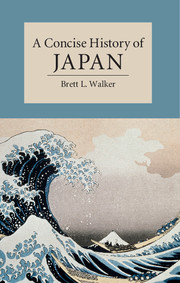Book contents
- Frontmatter
- Dedication
- Contents
- List of Illustrations
- List of Maps
- Preface
- Chronology
- Introduction
- 1 The Birth of the Yamato State, 14,500 bce – 710 ce
- 2 The Courtly Age, 710–1185
- 3 The Rise of Samurai Rule, 1185–1336
- 4 Medieval Japan and the Warring States Period, 1336–1573
- 5 Japan’s Encounter with Europe, 1543–1640
- 6 Unifying the Realm, 1560–1603
- 7 Early Modern Japan, 1600–1800
- 8 The Rise of Imperial Nationalism, 1770–1854
- 9 Meiji Enlightenment, 1868–1912
- 10 Meiji’s Discontents, 1868–1920
- 11 The Birth of Japan’s Imperial State, 1800–1910
- 12 Empire and Imperial Democracy, 1905–1931
- 13 The Pacific War, 1931–1945
- 14 Japan’s Post-War History, 1945–Present
- 15 Natural Disasters and the Edge of History
- Glossary
- Further Reading
- Index
10 - Meiji’s Discontents, 1868–1920
Published online by Cambridge University Press: 05 March 2015
- Frontmatter
- Dedication
- Contents
- List of Illustrations
- List of Maps
- Preface
- Chronology
- Introduction
- 1 The Birth of the Yamato State, 14,500 bce – 710 ce
- 2 The Courtly Age, 710–1185
- 3 The Rise of Samurai Rule, 1185–1336
- 4 Medieval Japan and the Warring States Period, 1336–1573
- 5 Japan’s Encounter with Europe, 1543–1640
- 6 Unifying the Realm, 1560–1603
- 7 Early Modern Japan, 1600–1800
- 8 The Rise of Imperial Nationalism, 1770–1854
- 9 Meiji Enlightenment, 1868–1912
- 10 Meiji’s Discontents, 1868–1920
- 11 The Birth of Japan’s Imperial State, 1800–1910
- 12 Empire and Imperial Democracy, 1905–1931
- 13 The Pacific War, 1931–1945
- 14 Japan’s Post-War History, 1945–Present
- 15 Natural Disasters and the Edge of History
- Glossary
- Further Reading
- Index
Summary
By the early twentieth century, Meiji reforms had refashioned the island country. Japan’s early modern experience, combined with the global trends of the nineteenth century, proved powerful enough to remake Japan into a burgeoning modern nation, transforming politics, society, and culture, along with the environment and many of the non-human organisms that lived on the archipelago. Both people and the natural world became artefacts of modern and industrial life. With bobbed-hair ‘modern girls’ and urban dandies sporting the newest Western attire, Japan came to share more in common with the modern industrial nations of Europe than it did with its former pre-Meiji self or its immediate neighbours. In this respect, Meiji reforms had reconfigured and rescripted virtually every aspect of the Japanese landscape and life, but often at great social and environmental cost. The Meiji period had a dark underbelly, one characterized by human hardship and early signs of the environmental problems invited by unbridled industrialization and the reliance on fossil fuels.
Changes in the Countryside
Meiji reforms weighed heavily on Japan’s new commoners, particularly those living in the countryside. By the mid-Meiji period, farmers in Japan cultivated about 11 per cent of the total land available in Japan, or approximately 4 million hectares (nearly 10 million acres), and that later rose to nearly 16 per cent, or close to 6 million hectares (nearly 15 million acres) in 1919. This contrasts with more contemporary practices: in the post-Pacific War years, Japan witnessed a precipitous decline in the number of farmers and farmer households. In 1965, the number of ‘core agricultural workers’ stood at 8.94 million people, but that number had declined to 2.24 million by 2005. In terms of hectares of land under cultivation, Japan declined from 6 million hectares in 1965 to 4.69 million in 2005, stabilizing around the mid-Meiji numbers. This is despite the fact that Japan’s population increased from just under 40 million in 1890 to nearly 128 million in 2005. These numbers suggest that, with Japanese paving over much of their farmland and rural populations declining rapidly, the island nation is on the cusp of not being able to feed itself. As we shall see, much of Japan’s rural turmoil can be traced to the Meiji Restoration and taxation policies.
- Type
- Chapter
- Information
- A Concise History of Japan , pp. 179 - 200Publisher: Cambridge University PressPrint publication year: 2015



